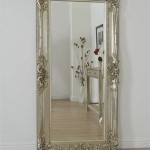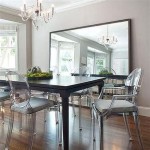How to Hang a Frameless Bathroom Mirror
Frameless bathroom mirrors offer a sleek, modern aesthetic. Their minimalist design complements various bathroom styles and creates an illusion of spaciousness. However, hanging a frameless mirror can be more challenging than a framed one due to the lack of a pre-existing hanging mechanism. This guide provides a comprehensive approach to safely and securely install a frameless bathroom mirror.
Planning and Preparation: Before beginning the installation, careful planning is crucial. Accurate measurements and proper placement contribute significantly to a successful outcome. Start by determining the desired mirror location on the wall. Consider factors like lighting, eye level, and proximity to other fixtures. Measure the mirror's dimensions precisely and mark the intended position on the wall using a pencil or painter's tape.
Choosing the Right Adhesive: Selecting the appropriate adhesive is paramount for secure installation. Consider the weight and size of the mirror when choosing an adhesive. Neutral cure silicone or mirror mastic are typically recommended for frameless mirrors due to their strong bonding capabilities and resistance to moisture. Avoid using acidic silicone as it can damage the mirror's backing. Consult product specifications for compatibility with your mirror type.
Gathering Necessary Tools and Materials: Having all the necessary tools within reach streamlines the installation process. Assemble the following items: measuring tape, level, pencil, painter's tape, safety glasses, gloves, adhesive, caulking gun, mirror clips (optional), spacers (optional), and a clean cloth.
Preparing the Wall Surface: The wall surface needs to be clean, dry, and free of dust or debris for optimal adhesion. Clean the designated area thoroughly with a suitable cleaning solution and allow it to dry completely. If necessary, lightly sand any uneven surfaces to create a smooth and level base for the mirror.
Applying the Adhesive: The method of applying the adhesive depends on the specific product chosen. For silicone or mirror mastic, use a caulking gun to apply even beads of adhesive to the back of the mirror. The beads should be spaced evenly across the mirror's surface, ensuring adequate coverage and support. Follow the manufacturer’s instructions for recommended bead spacing and size. Avoid applying adhesive too close to the mirror’s edges to prevent it from squeezing out during installation.
Positioning and Securing the Mirror: Carefully lift the mirror and align it with the marked position on the wall. Gently press the mirror against the wall, ensuring full contact with the adhesive. Use a level to verify proper alignment both horizontally and vertically. If necessary, use spacers to maintain consistent gaps between the mirror and the wall while the adhesive cures. Spacers can be small pieces of wood or tile.
Adding Mirror Clips (Optional): While not always necessary, mirror clips provide additional support and security, especially for larger or heavier mirrors. Install the clips according to the manufacturer's instructions, usually at the bottom and sides of the mirror. Ensure the clips are compatible with the mirror’s thickness and do not interfere with its aesthetic appearance.
Curing Time: Allow the adhesive to cure completely according to the manufacturer's instructions. This typically takes between 24 and 72 hours. Avoid disturbing the mirror during this period to ensure a strong and lasting bond. Do not remove any spacers until the adhesive is fully cured.
Cleaning and Finishing: Once the adhesive has cured, carefully remove any spacers. Clean any excess adhesive from around the mirror’s edges with a damp cloth. For a polished look, consider applying a thin bead of silicone sealant along the edges where the mirror meets the wall. This provides a waterproof seal and prevents moisture from seeping behind the mirror.
Safety Precautions: Throughout the installation process, prioritize safety. Wear safety glasses to protect your eyes from dust and debris. Use gloves to prevent skin irritation from the adhesive. If working with a large or heavy mirror, enlist the assistance of another person for safer handling and positioning.
Alternative Installation Methods: For specific mirror types or wall surfaces, alternative installation methods might be more suitable. J-channels and Z-clips are hardware options that provide mechanical support for the mirror. Consult with a professional if you are unsure about the best installation method for your particular situation.
Considerations for Different Wall Types: Different wall types may require specific considerations during installation. For drywall, ensure the wall anchors used for mirror clips are appropriate for the wall’s thickness and composition. For tile walls, it may be necessary to use a specialized adhesive suitable for bonding to tile surfaces.

How To Install A Mirror Without Frame Merrypad

How To Hang A Frameless Mirror On The Wall With Pictures
:strip_icc()/DesireeBurnsInteriors1-f76d25cad90041c88fbae4a7dc10aab4.jpg?strip=all)
2 Simple Ways To Hang A Frameless Mirror

How To Install A Mirror Without Frame Merrypad

How To Hang A Frameless Mirror On The Wall With Pictures

How To Hang A Frameless Mirror On The Wall With Pictures

How To Hang A Hanging Mirror Without Accompanying Hardware

How To Hang A Frameless Mirror On The Wall With Pictures

How To Hang A Frameless Mirror June 2024 Your Guide Hanging

3 Simple Ways To Hang A Mirror On Wall Without Nails Wikihow








